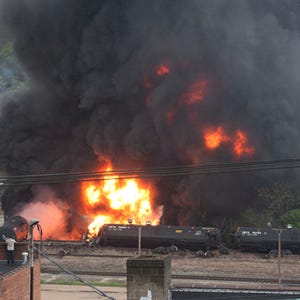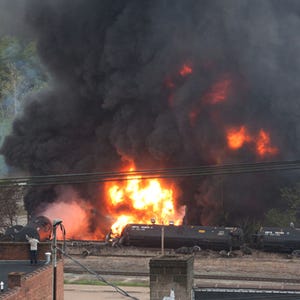
(Photo: LuAnn Hunt, AP)
Bart Jansen, USA TODAY
August 21, 2015
Federal investigators found damaged track at the spot in Lynchburg, Va., where an oil train derailed in 2014, sparking a huge fire and forcing the evacuation of six city blocks, according to documents released Friday.
A CSX train carrying Bakken crude oil derailed April 30, 2014, jumping the rails where joint bars had been bolted in place to reinforce broken track discovered in January 2014, according to National Transportation Safety Board (NTSB) documents.

CSX inspectors had checked the track the day before and ordered new rail to be installed within about three weeks, investigators reported.
The documents released Friday describe factual aspects of the crash and don't attempt to analyze what happened. The board will determine the probable cause of the crash and make saftey recommendations in the coming months.
Nobody was injured in the accident. But three of the 17 derailed cars plunged into the James River, where they leaked crude oil. Of the derailed cars, 14 were built to higher safety standards developed by the Association of American Railroads for cars delivered after October 2011, and three were built to the Transportation Department's legacy standard called DOT-111.

CSX estimated damage from the crash at $1 million.
Witnesses reported flames higher than four-story buildings, and emergency personnel evacuated about 350 residents and 20 businesses.

The Lynchburg crash was one of several in recent years that spurred greater federal attention to rail safety. As more trains deliver Bakken crude oil from North Dakota, federal officials have sought to strengthen rail cars against collisions and reduce accidents at grade-level crossings.
In contrast to a speeding Amtrak train that crashed in Philadelphia in May, the CSX train in Lynchburg was going 23 mph at a curve where the speed limit was 25 mph.